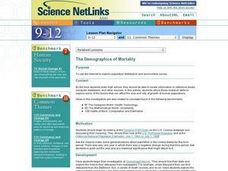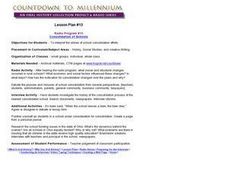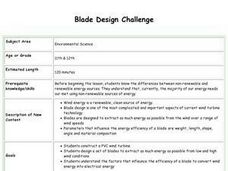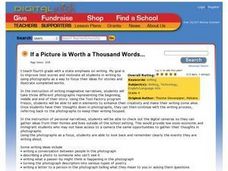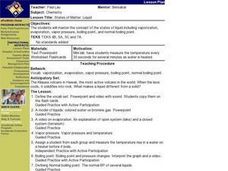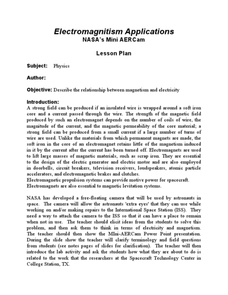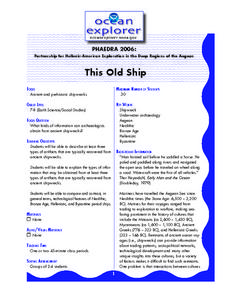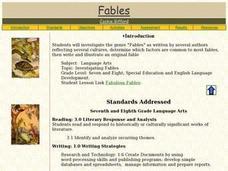Curated OER
Land Bridge Theory
Fifth graders observe a map that includes where the land bridge was located and that its name was Beringia and look in the Social Studies books to read about the Land Bridge Theory. The class then brainstorms reasons why they think...
Curated OER
The Demographics of Mortality
Students view the Dynamic POPClocks on the U.S. Census webpage and discuss their meaning. They explore age-related death rates of the human population and collect information about the deaths of humans and organize them into a life table.
Curated OER
The Rise of Responsible Government
Students complete a worksheet. Students search for required information from the Canada in the Making Web site (and other sources, if desired). They make observations and anticipate opposing arguments.
Curated OER
Belongs, Doesn't Belong
Fifth graders discover the rule used to sort a set of data into two sets, those data that belong according to the rule and those data that don't belong. Students participate in a game to determine the rule. They discuss strategies for...
Curated OER
Radio Program #13-Consolidation of Schools
Pupils interpret the stories of school consolidation efforts. They explore what social and structural changes have occurred in rural schools. Students debate the plusses and minuses of school consolidation from several perspectives.
Curated OER
Blade Design Challenge
Students identify the differences between non-renewable and renewable energy sources. They construct a PVC wind turbine and design a set of blades to extract as much energy as possible from low and high wind conditions.
Curated OER
If a Picture is Worth a Thousand Words...
Fourth graders take three different photographs representing the beginning, middle and end of their story. They use the Tool Factor program Fresco to add elements to enhance their creativity and make their writing come alive. They then...
Curated OER
States of Matter: Liquid
Students work in a mini lab where they measure the temperature every 30 seconds for several minutes as water is heated. They are asked what makes liquid different from a solid. Students view a PowerPoint on the model of liquids,...
Curated OER
Evolution
Students illustrate the results of natural selection by identifying the specific adaptation of an organism that allows the species to survive in that environment. They illustrate the results of natural selection by recognizing examples...
Curated OER
Alexander The Great
Students investigate the historical person of Alexander The Great. They view a video in order to create the context for the instructional activity. They read some biographies and conduct research using a variety of resources. Then...
Curated OER
Letters From The Diaspora
Students investigate the concept of mass migration and conduct research using a variety of resources. The information is used in order to create letters written from the perspective of a person who may have migrated during the time period.
Curated OER
Shopping Trip 2- Coin Identification Worksheet
In this coin identification worksheet, 1st graders cut out pictures of coins that are labeled with their value in cents. They place the coins next to the pictures and coin amounts.
Curated OER
Voil! C'est La Magie De La Chimie
Students examine chemistry and demonstrate the relevancy of it in their everyday world. In this chemistry lesson students complete a lab activity.
Curated OER
Inventions 2: The Impact
Students research inventors and inventions and their impacts. For this invention lesson, students research inventions and their affects in good and bad ways.
Curated OER
Electromagnitism Applications
Young scholars experiment on magnets and electricity. In this physics lesson, students determine what factors affect the strength of a magnetic field. They design an experiment to determine how electromagnetic field strength varies with...
Curated OER
People of the Cassini Team
Students discuss the job qualifications of a team member for a space mission. In this space science lesson, students select a mentor from the Cassini team members and explain the reason for their selection. They assess the...
Curated OER
Plotting Numbers and Test
Sixth graders create a human number line. They determine the correct placement of various numbers ranging from -4 to 4. Additionally, they will determine the placement of numbers written as fractions and/or decimals.
Curated OER
Multiplying Polynomials
Help learners study polynomials. They will review how to multiply polynomials either by using the FOIL method if they are multiplying a binomial by another binomial, or by using the distributive property.
Facing History and Ourselves
Do You Take the Oath?
Why did so many go along with Nazi policies during World War II? An investigatory unit includes four handouts, reading analyses, classroom discussion topics, and intriguing philosophical questions, helping learners understand the...
Cave Creek Unified School District
Crusades and Culture in the Middle Ages
The Crusades sounds like a glamorous time period in the Middle Ages full of glory—but was it? Scholars find and review the truth of the Crusades' influence on the world through the resource. The study guides, separated individually by...
Curated OER
This Old Ship
Junior archaeologists will be able to describe shipwreck artifacts and the information they reveal. They work in small groups to reasearch wreckage features of different period ships, making this not only a science lesson, but a social...
Curated OER
Investigating Fables
Time for a story! Learners of all ages enjoy listening to stories, so read them some common fables and have them work cooperatively to create a fable. Differentiate for varying ability levels by providing sentence frames, graphic...
Curated OER
Anticipation Guide for Of Mice and Men Chapter 3
Before reading chapter three in Steinbeck's Of Mice and Men, provide your class with this prereading activity. Readers study nine questions to determine how the events of chapters one and two will affect chapter three. Get your kids...
EngageNY
Matrix Multiplication and Addition
To commute or not to commute, that is the question. The 26th segment in a 32-segment lesson focuses on the effect of performing one transformation after another one. The pupils develop the procedure in order to multiply two 2 X 2...



